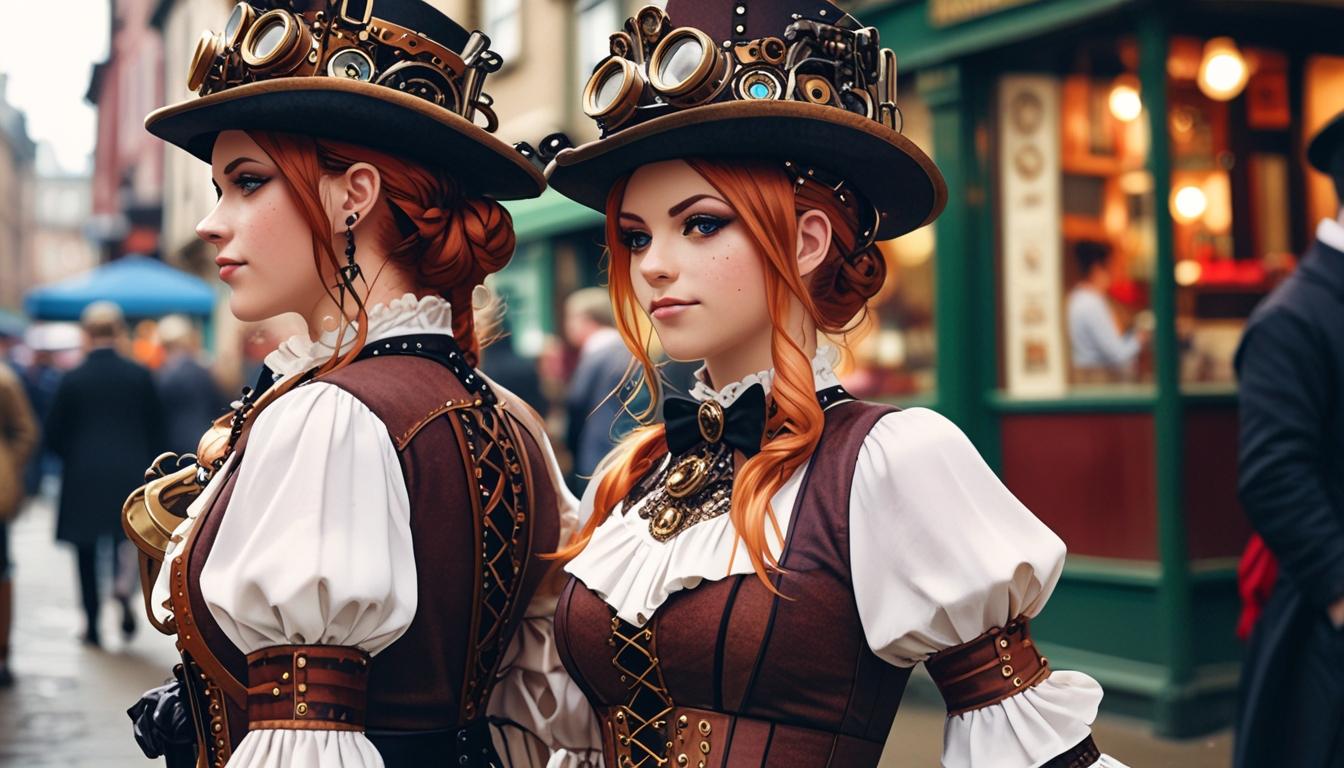When you think about "The Royal Tenenbaums," you can't ignore how the outfits shape the characters' identities and the overall narrative. Each costume, carefully chosen by Karen Patch, offers insights into the characters' emotional states and relationships. For instance, Chas's tracksuit isn't just a fashion choice; it reveals a deeper layer of his personality. But what about Margot's iconic style or Richie's nostalgic flair? These outfits do more than clothe—they tell a story, and exploring their significance might just change how you view the film. What might the choices say about the characters themselves?
Overview of Costume Design
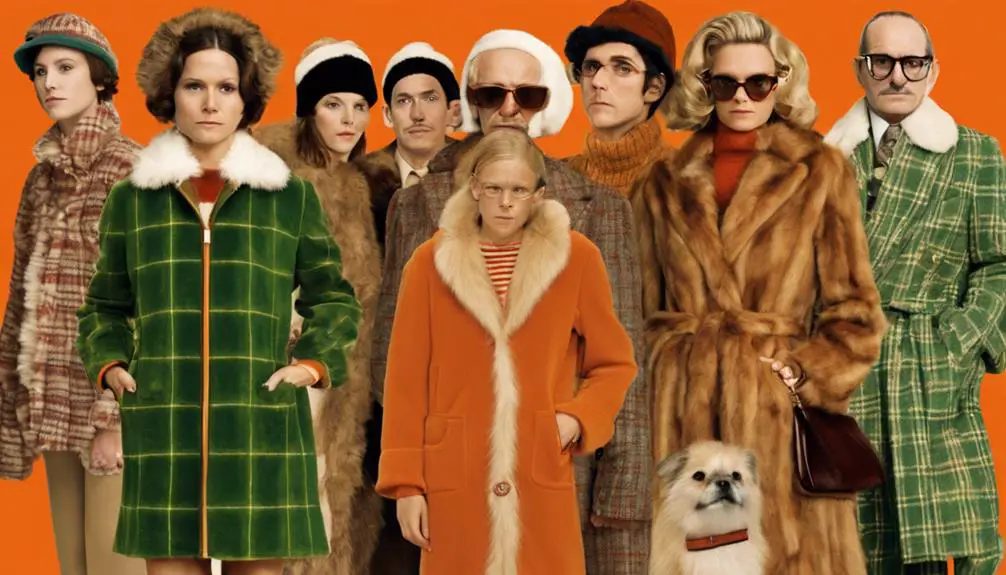
In "The Royal Tenenbaums," costume designer Karen Patch crafted a visual tapestry that vividly reflects each character's essence. Her distinctive clothing choices play an essential role in conveying the film's themes of nostalgia and arrested development. Each character's wardrobe showcases their struggles with adulthood, capturing moments that feel both poignant and relatable.
By opting for custom-made costumes, Patch guaranteed that every piece was original, adhering to Wes Anderson's directive to avoid store-bought items. The collaboration with brands like Lacoste and FILA resulted in iconic pieces that not only resonated with the film's unique aesthetic but also aligned perfectly with the characters' identities.
You can see how the colors, patterns, and styles speak volumes about their personalities and familial connections. The attention to detail in these costumes doesn't just enhance the visual experience; it sets a new standard for costume design in film.
Ultimately, Patch's work in "The Royal Tenenbaums" contributes greatly to the ongoing cultural impact of the film, proving that clothing can be a powerful narrative tool. You can't help but admire how it all comes together to create a lasting impression on audiences.
Character Wardrobes
Drawing inspiration from their unique backgrounds and emotional states, the wardrobes of the Tenenbaum family reveal much about their inner struggles and relationships.
Royal Tenenbaum, for instance, dons a pinstriped suit and tie, a striking visual representation of his regrets and past failures within the family dynamic. In contrast, Chas Tenenbaum's red Adidas tracksuit exudes a sense of neuroticism, reflecting his desire for protection after the family's decline.
Richie Tenenbaum's signature style, featuring a FILA polo shirt and sweatband, showcases his nostalgic connection to his past as a tennis prodigy, embodying both triumph and heartbreak.
Meanwhile, Margot Tenenbaum's wardrobe is defined by a striped Lacoste dress paired with a luxurious fur coat, illustrating her complex identity and emotional struggles that lie beneath her polished exterior.
The uniformity in clothing among the Tenenbaum family members not only highlights their shared history but also emphasizes their individual battles with adulthood.
Each outfit is carefully curated, contributing to a rich tapestry of personal stories that connect them, making their collective style as compelling as the characters themselves.
Collaboration and Creation Process
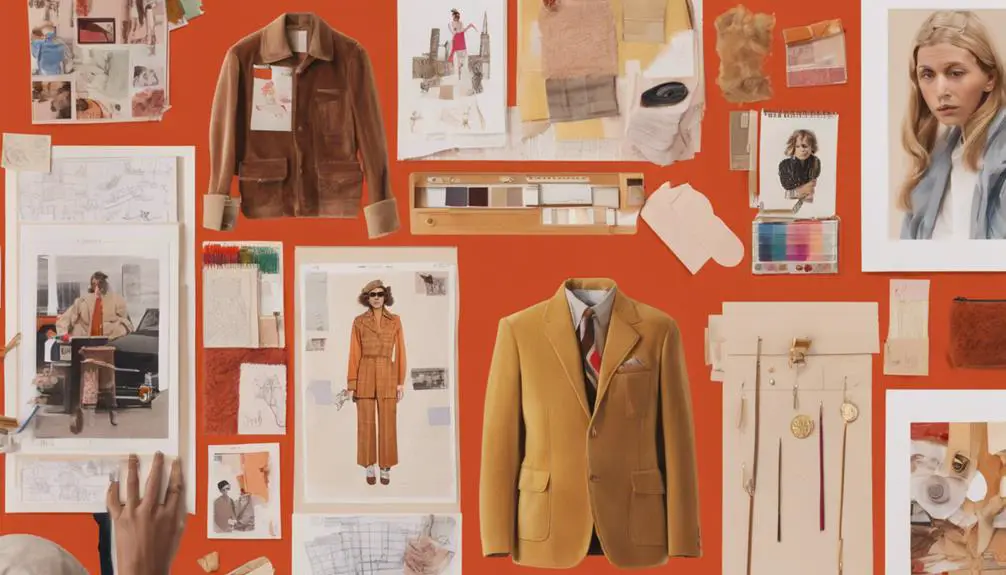
Costume designer Karen Patch played a pivotal role in shaping the visual identity of "The Royal Tenenbaums" through her collaboration with Wes Anderson. From the very beginning, they worked closely to guarantee that every costume aligned with Anderson's unique vision and style.
You'll find that every piece was crafted from scratch, adhering to Anderson's directive to avoid store-bought items, which truly added originality to the film's wardrobe.
Eric Anderson's pre-production drawings greatly influenced the designs, allowing the costumes to visually reflect the characters' personalities and narratives. This attention to detail not only enhanced the storytelling but also brought a sense of authenticity to each character.
Patch obtained approval from brands like Lacoste and FILA for custom designs, guaranteeing that the wardrobe maintained brand integrity while fitting seamlessly into the film's aesthetic.
Their daily collaboration created a dynamic environment where ideas flowed freely, resulting in a wardrobe that not only complemented the film's overall look but also enriched its storytelling.
The commitment to original designs showcased both Patch's talent and the importance of collaboration in creating such a memorable visual experience.
Themes and Symbolism
The costumes in "The Royal Tenenbaums" do more than just dress the characters; they act as powerful visual metaphors that reveal their emotional struggles with nostalgia and identity. Take Chas Tenenbaum, for example, whose red Adidas tracksuit symbolizes his vigilance and desire to protect his family, reflecting his neurotic personality.
The attention to detail in the costumes is akin to identifying vintage styles, where each piece tells a story about its era, much like identifying vintage Ralph Lauren items through their unique characteristics. Margot's style, particularly her striped Lacoste dress paired with a mink coat, evokes a sense of childhood nostalgia while contrasting sharply with her adult feelings of disconnection and failure.
The consistent use of stripes throughout the film visually links the Tenenbaum family, emphasizing their shared history despite individual struggles. This motif serves to highlight the complexities of their relationships, as they navigate the highs and lows of their intertwined lives.
Richie's character arc is particularly compelling; his evolving wardrobe choices, culminating in a head shave, illustrate his journey toward acceptance and a departure from childhood nostalgia, particularly his tennis pursuits.
In essence, the characters' outfits not only showcase their unique styles but also deepen our understanding of their emotional landscapes, making the costumes integral to the film's narrative.
Cultural Impact and Legacy
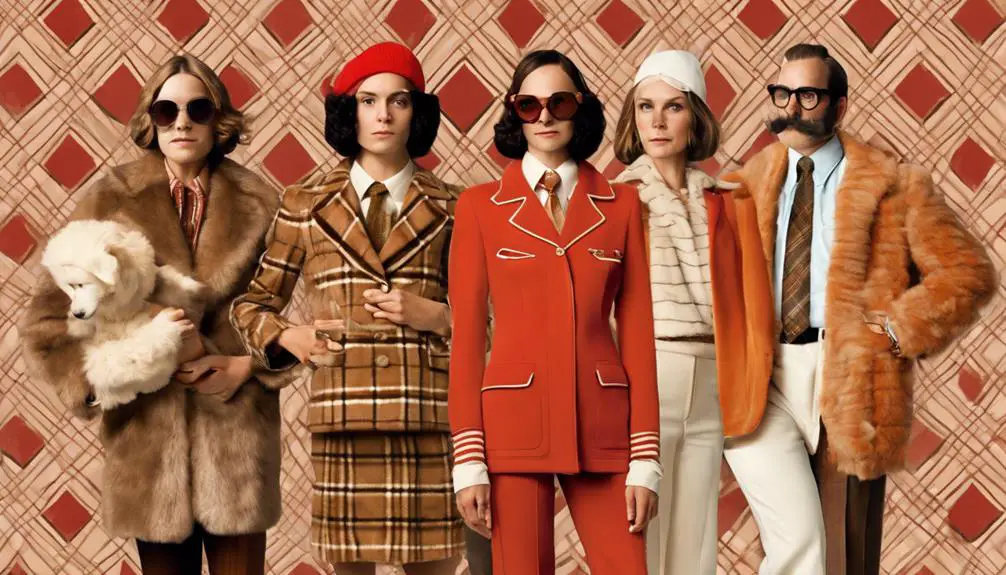
With its striking visual style, "The Royal Tenenbaums" has left an indelible mark on both fashion and film. The distinct costumes created by costume designer Karen Patch have become cultural landmarks, inspiring fashion trends and Halloween costumes for over two decades.
Patch's work set a new standard for film wardrobe, prompting collaborations with major fashion houses like Gucci and Miu Miu that pay homage to the film's unique aesthetic.
The film's blend of nostalgia and irony in wardrobe choices continues to spark interest and analysis within both fashion and film communities. Iconic looks, such as Margot's fur coat and Richie's camel suit, resonate deeply with audiences, establishing a lasting legacy in contemporary fashion.
These costumes evoke a sense of familiarity and nostalgia, ensuring their place in pop culture history and influencing modern designers who seek to capture that same spirit.
The enduring impact of "The Royal Tenenbaums" on the fashion industry showcases how effective costume design can transcend the screen, shaping trends long after the credits roll.
You'll find that its legacy continues to inspire creativity and individuality in wardrobes around the world.
Iconic Style of Margot Tenenbaum
Though often viewed as a complicated character, Margot Tenenbaum's style is a striking blend of sophistication and youthful rebellion that captures attention. Her signature look, featuring a long mink coat draped over a classic striped Lacoste dress, perfectly encapsulates her unique aesthetic. The addition of a Hermès Birkin bag not only enhances her outfit but also symbolizes her status as a fashion icon.
Her vintage-inspired choices mirror the evolution of luxury brands like Gucci, which have a rich history of iconic styles and cultural impact, evident in their decade-specific tags. Margot's heavy black eyeliner and blunt bob hairstyle add to her mysterious persona, reflecting the emotional struggles she faces within her family.
This consistent aesthetic showcases her detachment, making her an iconic figure in the world of fashion. Margot Tenenbaum's influence continues to resonate, evident in collections like Gucci's Fall 2015 line, which drew inspiration from her distinctive looks.
Her enduring appeal is also highlighted by her frequent representation in Halloween costumes and runway shows, proving that her style transcends time. Whether you're channeling her vibe for a costume party or simply appreciating her fashion legacy, it's clear that Margot Tenenbaum remains an unforgettable symbol of chic rebellion and emotional complexity.
Richie's Nostalgic Fashion Choices
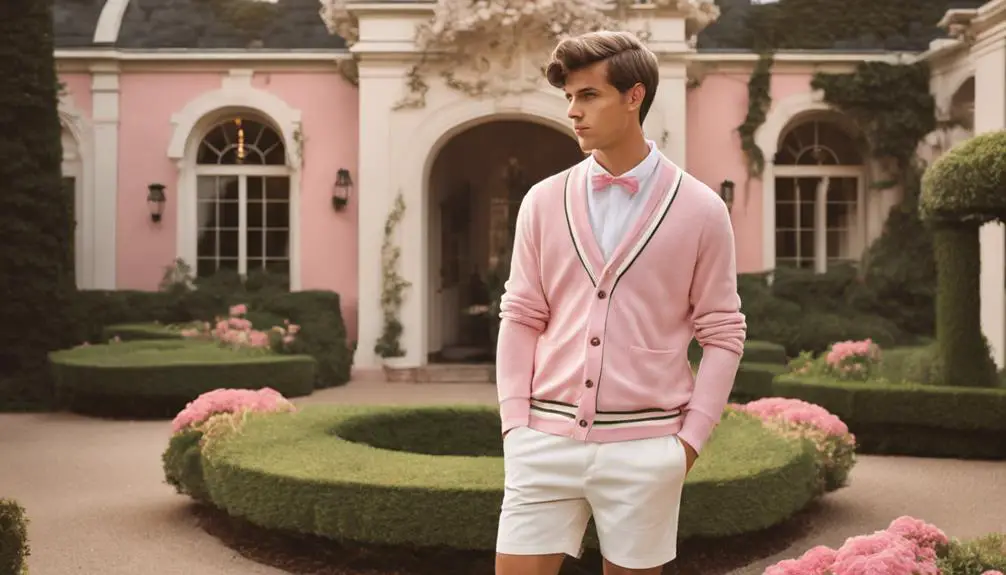
During his journey in "The Royal Tenenbaums," Richie Tenenbaum's fashion choices reveal a deep nostalgia for his past as a tennis prodigy. His signature contemporary camel suit, a perfect blend of retro style and sophisticated flair, reflects his longing for the glory days on the court. The addition of a Fila tennis headband not only showcases his athletic roots but also symbolizes the innocence of his childhood, creating a striking contrast to his washed-up persona.
Richie's muted autumnal color palette, featuring earthy tones and beige ribbed socks, enhances this nostalgic vibe while balancing sophistication with an air of scruffiness. His choice of chocolate brown loafers further illustrates his internal conflict, walking the fine line between looking polished and feeling lost.
This sense of nostalgia is reminiscent of vintage fashion trends that evoke a similar longing for the past, as seen in Nike's brand history. At the film's climax, Richie's dramatic head shave marks a pivotal transformation in his character arc, symbolizing acceptance of his feelings and struggles with adulthood.
This moment, coupled with his nostalgic fashion, reflects his journey from aspiration to reality, resonating deeply with viewers who can relate to the bittersweet nature of growing up. Richie's style is more than just clothing; it's a visual narrative of longing and self-discovery.
Chas Tenenbaum's Athletic Aesthetic
As Chas Tenenbaum navigates the chaos of his family life, his signature bright red Adidas Firebird tracksuit becomes a symbol of his neurotic need for control. This athletic aesthetic not only reflects his protective instincts but also highlights his struggle to shield his children from the dysfunction surrounding them.
Wearing the tracksuit, Chas contrasts sharply with his past as a successful businessman, signifying his decline and the weight of adult responsibilities he grapples with daily.
Chas's choice of attire aligns perfectly with the film's theme of arrested development, showcasing how he clings to childhood comforts while facing the pressures of parenthood. His coordinated outfits with his sons reinforce a sense of family unity, emphasizing their shared challenges and his determination to create stability amidst turmoil.
Each matching tracksuit serves as a visual reminder of their bond, even as they confront their chaotic lives together.
Through Chas Tenenbaum's vibrant Adidas Firebird tracksuit, we see a man caught between the desire for control and the acceptance of his family's reality, making his athletic aesthetic a poignant representation of his character's journey.
Frequently Asked Questions
What Inspired Wes Anderson's Unique Color Palette for the Film's Outfits?
Wes Anderson's color palette reflects character psychology and seasonal themes. You'll notice vintage influences and color symbolism throughout, enhancing the art direction while creating a visually distinct narrative that draws you into the characters' emotional landscapes.
How Did the Actors Influence Their Characters' Wardrobe Choices?
You'll find that actor collaboration shapes wardrobe symbolism considerably. Each actor's personal style influences character development, ensuring that fashion impacts the overall narrative, creating a distinct visual identity that resonates with the audience throughout the film.
Are There Any Hidden References in the Outfits Throughout the Film?
When it comes to hidden symbolism, you'll find layers of character development within the fashion. Each outfit weaves in cultural influences and fashion history, creating visual storytelling that's as rich as the characters themselves.
Where Can I Purchase Replicas of the Film's Iconic Costumes?
You can find replicas of iconic costumes at replica costume shops, online vintage boutiques, or through custom tailoring services. Check thrift store finds and designer collaborations for unique pieces that capture the film's distinctive style.
Did the Costumes Evolve During the Film's Production Process?
Did you ever wonder how costume design can reflect character evolution? Throughout production, influences shaped the stylistic choices, intertwining fashion symbolism with each character's journey, creating a visual narrative that enriches the overall storytelling experience.


